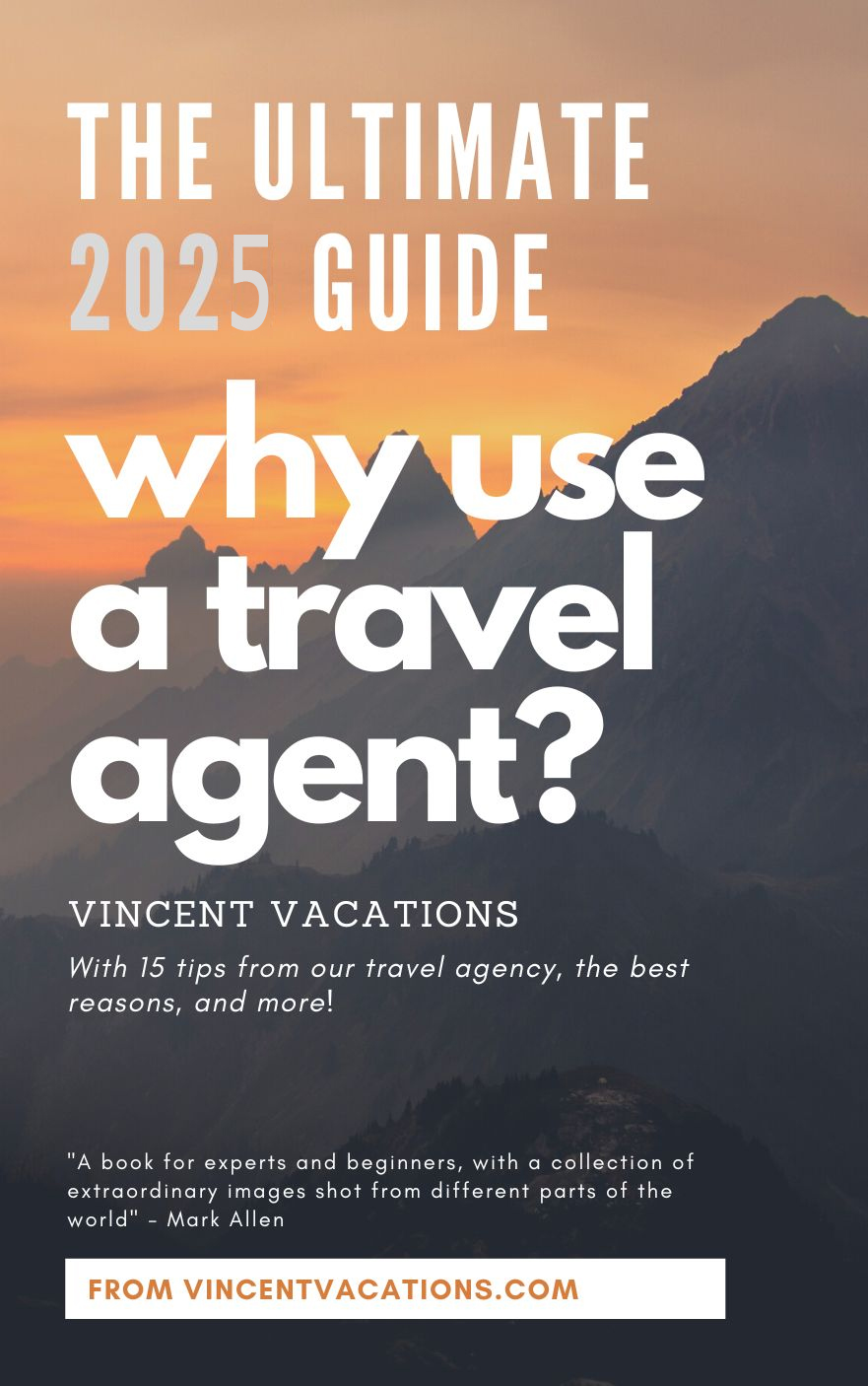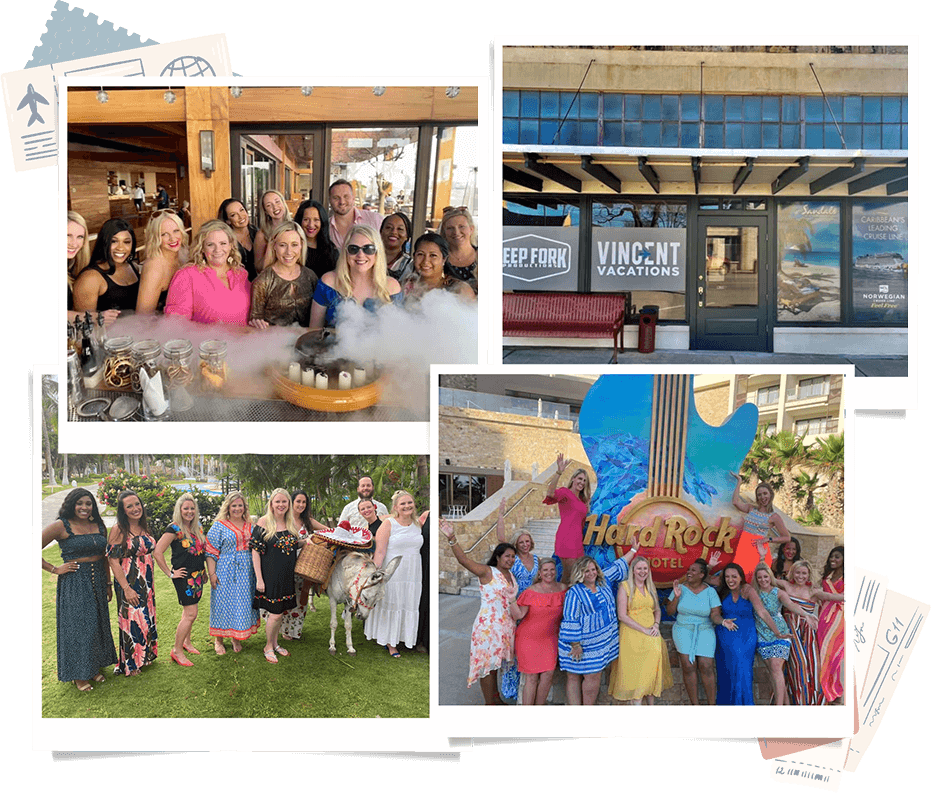Think Big!
Viva Las Vegas A few weeks ago, I had an amazing opportunity to attend the annual Signature Travel Network conference in Las Vegas. For those who don't know what this conference is, it is a huge conf...
Read moreWe recognize that Disney vacations are not just an investment, but often the highlights of our lives, and we take that responsibility seriously. We want to ensure you have the best vacation experience. Interested in a job in travel? Click here to learn: How to Become a Disney Travel Agent
Jump to section: A B C D E F G H I J K L M N O P Q R S T U V W X Y ZSee our Disney travel agents near me.
A vacation in Arkansas has as much to do with rejuvenation as relaxation. The waters of Eureka Springs and Hot Springs have long been known for their healthful qualities, and the state offers additional ways to make visitors feel better: fishing on a scenic lake, walking a wooded trail, contemplating the beauty of a mountain road. Other activities may seem more silly than holistic (petting an alligator, for instance, or watching the World Championship Duck Calling Contest), but all of our research indicates that having fun can be good for you. Arkansas is also home to the Clinton Library, the largest archival collection on American presidential history in the U.S.
Arkansas is also restorative in the sense that it tries to preserve a lot of its past. Sometimes that takes place through historic forts, vintage buildings and presentations of traditional music and crafts; sometimes through the general sense that life moves at a relaxed pace reminiscent of previous decades. Those who like the high energy and sophisticated entertainment of big cities may want to go elsewhere, but if you want to take it easy and enjoy beautiful, rural scenery, Arkansas is a good place to do that.
Arkansas' early residents found that the area's rich bottomlands were good for growing crops. By AD 700, these Native American farmers were raising enough food to support the relatively advanced Mississippian or Temple Mound Builder culture that came to dominate the area. They lived in large villages and often constructed elaborate ceremonial earthworks (some of which can be viewed at Toltec Mounds State Park, near Little Rock). But by the early 1600s, the large villages had been abandoned. When French explorers arrived in the late 1600s, they found only small Caddoan villages strung along the riverbanks.
The French created the first European settlement in 1686, but it didn't lure many settlers. During the 1700s, the area was under Spanish control. In 1800, it went back to France and soon after became part of the U.S. as a result of the Louisiana Purchase. Under new management, so to speak, Arkansas saw a wave of settlers arrive. The rich lands along the Mississippi River attracted slave-owning planters and brought the Southern plantation tradition to eastern Arkansas. Settlers from Appalachia came into the Ozark and Ouachita Mountains, probably because it was much like the lands they had left. During the Civil War, Arkansas was divided: Although it seceded, nearly 10,000 of its residents fought for the Union.
Arkansas was driven by an agricultural economy well into the 20th century. Not until the 1950s, in an effort to combat declining revenues and population, did the Arkansas Legislature back a plan to attract industry to the state. Today, Arkansas still grows a lot of rice, cotton and soybeans and is one of the largest poultry producers in the world. It also manufactures electronic equipment and wood-related products.
Arkansas is home to a number of major corporations, including Wal-Mart Stores, J. B. Hunt (trucking) and Tyson Foods. These are found in the northwestern part of the state near the University of Arkansas in Fayetteville, and the combination has helped create a prosperous, fairly urbane enclave complete with abundant white-collar jobs and its own airport. Arkansas' overall economy has also been strengthened by the many retirees who have moved to Hot Springs and mountain resorts.
Arkansas' main attractions are historic sites, scenic forests, hills and mountains, Eureka Springs, mineral baths, Hot Springs National Park, festivals, boating, hunting, fishing, waterskiing, the Ozarks, a diamond mine, a small theme park, Thoroughbred horse racing, the Wal-Mart headquarters and eclectic Visitors Center, and the William J. Clinton Presidential Center and Park.
Travelers who enjoy beautiful scenery and an unhurried atmosphere will have a great time in Arkansas. Those who seek the bustle and sophistication of big cities, who are interested solely in coastal or winter sports or who have a low tolerance for rural locales and folk culture will find the state less to their liking.
Ernest Hemingway spent some time in Piggott, in far northeast Arkansas, the hometown of his second wife, Pauline. The Hemingway-Pfeiffer Museum preserves the home of Hemingway's inlaws and a barn/studio where the author worked.
Hatchet Hall, in Eureka Springs, was the final home of Carrie Nation, the axe-wielding prohibitionist who terrorized saloons at the turn of the 20th century.
As its name indicates, Texarkana is partly in Texas and partly in Arkansas.
Spanish explorer Hernando de Soto is believed to have passed through Arkansas in the 1540s and may have visited a Native American village in the eastern part of the state. Parkin Archaeological State Park (northwest of West Memphis) commemorates the site. Visitors can watch the ongoing excavations of the settlement—it's a chance to see how history is pieced together from shards.
Craft making wasn't always as alive and well in the Ozarks as it is today. The old skills had practically disappeared in the late 1950s when University of Arkansas Extension Service agents began bringing in instructors to revive craft-making as a way to increase incomes of rural people. Today, one of the state's biggest draws is the annual craft fairs in northwest Arkansas. Thousands of tradesmen and visitors come to the area each spring and fall to enjoy the twice-yearly fairs, which coincide with the changing seasons.
Travelers enamored of the alleged healing power of quartz crystals will want to stop in Mount Ida, the Quartz Crystal Capital of the World. You can buy the sparkling stones in shops along the road or rent a pick at the hardware store and find them yourself at quarries in the Hot Springs/Mount Ida area.
As far as we know, Arkansas is the only state where opposing political candidates actually went to war against each other. In the 1870s, two rivals for the governorship both claimed victory; they backed up their claims with armed troops, who fought a few small battles. President Ulysses S. Grant settled the conflict.
Alma calls itself the Spinach Capital of the World and has staked its claim with a huge concrete statue of Popeye.
Arkansas leads the nation in the production of artificial fishing lures.
Famous Arkansans (besides Bill Clinton) include Wal-Mart founder Sam Walton, actor/filmmaker Billy Bob Thornton and country-music legend Johnny Cash.
Wyatt Earp spent some time in Arkansas, where in 1871 he was charged with horse theft in Van Buren. He escaped the charges and went on to pursue his legendary career in law enforcement.
Long before Bill Clinton, Arkansas' first presidential candidate was actually William Hope "Coin" Harvey, who ran as a third-party candidate against Franklin D. Roosevelt and Herbert Hoover in 1932. His campaign headquarters were in Monte Ne, a famous resort of the time known for its likeness to both Eureka Springs and Hot Springs.
The Midwest doesn't get any more middle than Kansas. In fact, the exact middle of the continental U.S. is found there, and the state's western geography has all the flatness you would expect from an area known as the Great Plains. Many travelers mistakenly jump to the conclusion that "plain" also means ordinary—or downright dull—and that the middle is not the place to be. They either avoid the state or streak across it to places where the land is steeper and the waters are wilder.
While Kansas may not have an ocean or a mountain range, it does have a subtle beauty and a slower pace that we always enjoy. (We're not afraid to say it: We like driving down long stretches of two-lane road, surrounded by miles/kilometers of rippling wheat. It gives a sense of calm and vastness that's not found in many other places.)
Kansas also offers its share of oddities (such as the world's largest public concrete swimming pool and largest ball of sisal twine), fascinating geological features and outdoor activities (lots of hiking and fishing). And besides its location in the middle of the country, Kansas is smack-dab in the middle of U.S. history, too, with a large number of sites that will help you better understand the course of westward expansion, the struggle over slavery and the wide-open expanses crossed during cattle drives.
The first tribes who lived in the land that would become Kansas survived largely by hunting, with the bison as their favorite game. This way of life continued for centuries but may have ended several hundred years before European contact: A drought in the 1200s may have forced many Native Americans to move elsewhere. When the first Spanish explorer, Francisco Coronado, arrived 300 years later, the tribes in the area were farmers. This changed once the Spaniards introduced horses to the area. Once they had access to horses, the tribes of the Great Plains again became nomadic buffalo hunters.
After Coronado and a later Spanish expedition led by Juan de Onate in 1601, few Europeans ventured into Kansas for the next 200 years. Of those, most were French traders. When the U.S. gained control of the area with the Louisiana Purchase in 1803, settlement began to take hold. During the 1820s, the Santa Fe Trail was opened across Kansas to allow trade with the Spanish settlement in what is now New Mexico. Wagon trains continued to follow that route, and the Oregon Trail, through the 1880s.
In 1854, Kansas became a territory with passage of the Kansas-Nebraska Act, which also stipulated that citizens of the territory would vote on whether or not to permit slavery. Kansas was soon embroiled in the bitter conflict that would ultimately lead to the Civil War. People on both sides of the issue flooded into the territory in hopes of controlling the state's destiny, and violence broke out.
"Bleeding Kansas" became the territory's nickname as armed bands staged vicious attacks on their opponents. Among the combatants was John Brown who, along with his sons, murdered five pro-slavery men on the Pottawatomie River. Finally, in 1859, the abolitionists won out, and Kansas became a free state two years later.
Residents continued to suffer from the slavery controversy, however. After the Civil War began in 1861, the state contributed more soldiers who would die in the war than any other Union state, per capita. In 1863, a pro-Confederate force led by William Quantrill sacked the town of Lawrence, which was a hotbed of abolitionist sentiment.
Following the Civil War and the introduction of the railroad, Kansas became the destination of great longhorn cattle drives north from Texas. Such celebrated cow towns as Abilene and Wichita became widely known. The Homestead Act and the desire for free land also attracted people to Kansas. More than 20,000 African Americans, popularly known as Exodusters, moved to Kansas from the South in the 1870s seeking land. Many African-American townships were settled during this time, of which only tiny Nicodemus remains.
The state continued to grow in spite of various problems: a plague of grasshoppers in 1874, Native American attacks on homesteaders and the activities of such outlaws as the Dalton Gang. Today, Kansas has settled down, but farming and cattle ranching remain two of its economic mainstays: It's the largest producer of wheat in the U.S. and one of the highest producers of beef. The aviation industry is a strong presence in Kansas, as are the natural gas and petroleum industries.
The main attractions in Kansas include cowboy heritage, pioneer history, military forts, Dodge City, Abilene, vast colorful skies, the Santa Fe Trail, the Flint Hills, amber waves of grain, Wichita, the history of space flight and auto racing.
Travelers who prefer a wide-open, leisurely, uncrowded atmosphere to the urban sprawl of major metropolitan areas will enjoy their visit to Kansas. Those travelers who feel that long-distance driving is tedious may find the state less to their liking.
Because early settlers found much of Kansas too hard to plow—there was only a thin layer of soil over a layer of flint—Kansas boasts the largest native tallgrass prairie in the nation.
Cheyenne Bottoms is the country's largest interior marsh—about 45% of the North American shorebird population stops there during spring migration.
The Santa Fe, Chisholm and Oregon trails all passed through what is now Kansas. A more recent overland route—Route 66—also passes through southeast Kansas. After President Dwight D. Eisenhower—a native Kansan—signed the Federal Aid Highway Act in 1956 for a national system of highways, Kansas was the first state to open an interstate highway (a portion of Interstate 70).
The Davis Memorial in a cemetery in Hiawatha contains 11 life-size carved stone sculptures depicting a couple at various points during their lives.
A marker for the geographic center of the contiguous United States is about 2 mi/3 km northwest of Lebanon. The geodetic center (an important reference point in precise mapmaking) is about 40 mi/65 km south of there on a private ranch.
In 1905, two University of Kansas professors discovered that Kansas had a plentiful supply of helium among its rich natural gas reserves. At the time, helium had only limited uses, but during World War II, helium-filled blimps played a major role in protecting Allies against German submarines. Kansas is the nation's top producer of helium.
Underground salt caverns, 650 feet below the earth’s surface near Hutchinson, are used to store Hollywood films, as well as important documents, papers and other information for companies from around the world.
The term "red-light district" may have originated in Dodge City, where railroad workers would hang their lanterns outside the brothels.
A boulevard is all that separates Kansas City, Kansas, from Kansas City, Missouri, so visitors may want to take in many of the attractions across the border in Missouri. Although Missouri's is the larger of the two cities, there are a number of things to see on the Kansas side of the line.
Be sure to check out the Rosedale Memorial Arch. It was modeled after the Arc de Triomphe in Paris and honors soldiers who fought in World War I. Trails and a boat ramp provide both a good view of downtown Kansas City, Missouri, and river access to the Kansas and Missouri rivers—all at the Lewis and Clark Historic Riverfront Park at Kaw Point.
The Mahaffie Stagecoach Stop & Farm, in Olathe, is the last remaining stagecoach stop on the Santa Fe Trail and celebrates the Santa Fe Trail during Bullwhacker Days (September). Other sites include the Shawnee Mission State Historic Site and Old Shawnee Town, a restored village of original and replicated structures, both in Shawnee.
One of the biggest attractions in the state is the nearby NASCAR racetrack, the Kansas Speedway. Near the Speedway is Village West, an upscale retail, hotel and entertainment district.
Vincent Vacations - Authorized Kansas Vacation Planner
Questions? Call us at
1 (888) 976-0061
For Groups of 10
or more rooms, or 8 or more Cabins, please use of Group Form
Click Here for our Group Department
Click on a location below to learn more. We recognize that vacations are not just an investment, but often the highlights of our lives, and we take that responsibility seriously. We want to ensure you have the best experience.

All of these are signs that you are a great fit to become an independent travel agent, and turn your love of travel from passion into profit!
Learn MoreOur motto at Vincent Vacations is, we go so you know! We want to ensure you have the BEST experience, whether it's a river cruise, or a corporate group incentive trip, we want to ensure your vacation is a success.
We serve customers all across the USA
Debt free and in business since 2013. Vincent Vacations has agents in Dallas, Kansas City, Houston, Shreveport, Little Rock, Roswell, Oklahoma City and more locations.

Travel agents can help save time and stress by doing the research and handling all your bookings for you. An experience travel agent is best at finding great deals and packages, as well as providing you with helpful information and tips. They can also help you plan special activities and experiences that you may not have thought of on your own. All in all, using a travel agent can be a great way to make sure you get the most out of your trip.
In travel since 2002, and in business since 2013, our travel team serves clients all over the US! Planning a vacation away from home takes a great team. We have taken the time to build a team of dedicated, smart, hard-working personnel who are each committed to excellence and service. We work side-by-side, creating and ensuring INCREDIBLE vacation experiences for you and your group. Our store front in-office team, and our travel consultant independent contractors, work all around the US.


In business since 2013, we are your #1 source for travel!
Free Vacation Package Quote